Behind The Lens: Patek Philippe Ref. 5950A-001 Split-Seconds Chronograph
by GaryG
Given my recent musings on these pages about the relative roles of rarity and complication in driving the value of a watch (see The Value Of Rarity: Christie’s Auctions A Black-Dialed A. Lange & Söhne Lange 1 In Stainless Steel), it seems appropriate to dedicate this “Behind the Lens” entry to a piece that is both complicated and limited in production: Patek Philippe’s Reference 5950A.
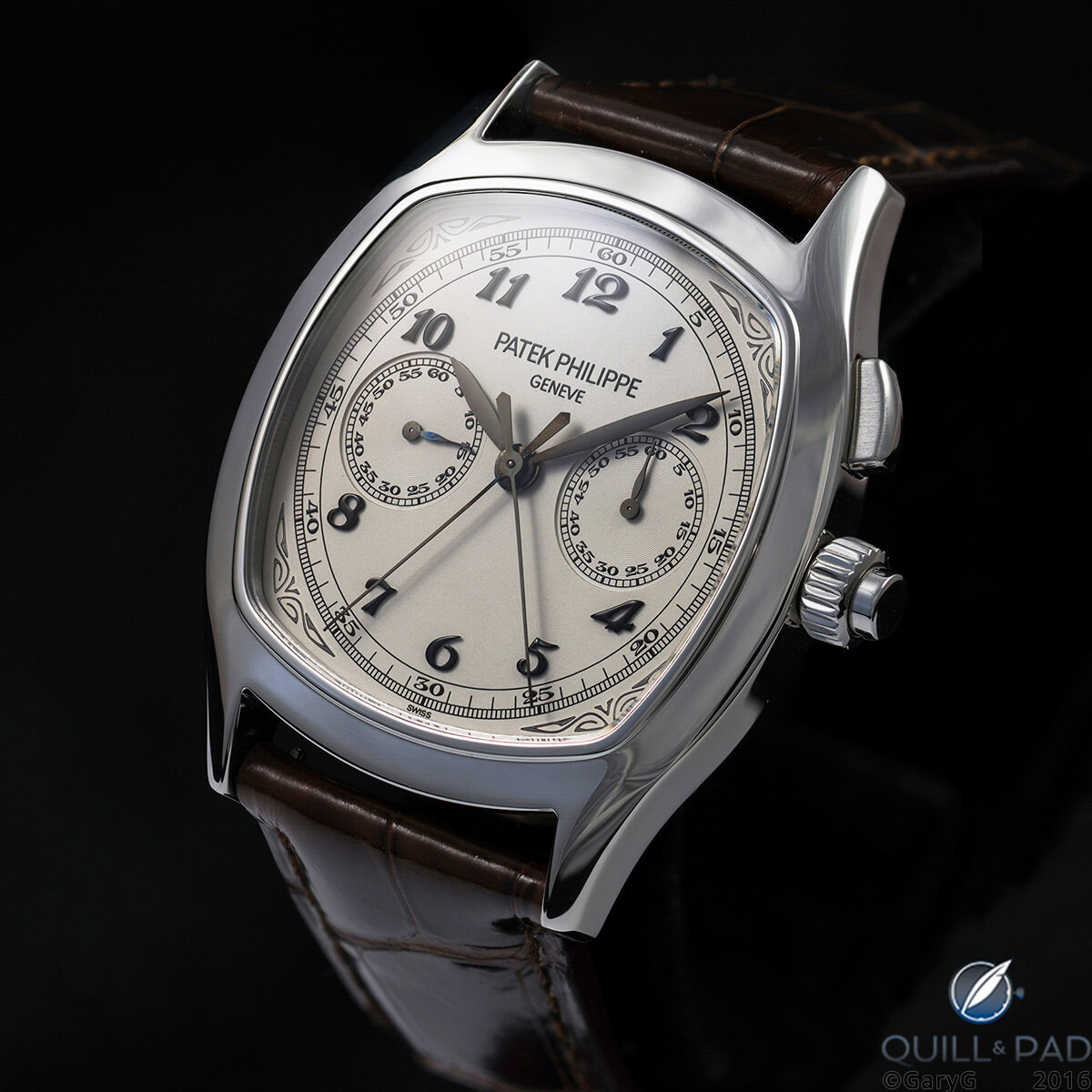
Patek Philippe Reference 5950A-001
What’s so special about this watch? Well, first of all it’s a split-seconds chronograph, and a monopusher at that, meaning that the start-stop-reset functions of the main chronograph are controlled through a single pusher that in this case is concentric with the winding crown.
On top of that, its Caliber CHR 27-525 PS movement is the world’s thinnest monopusher split-seconds at only 5.25 mm in thickness.
And the icing on the cake is that, like many of the most treasured vintage Patek Philippe dress watches, it is clothed in a stainless steel case.
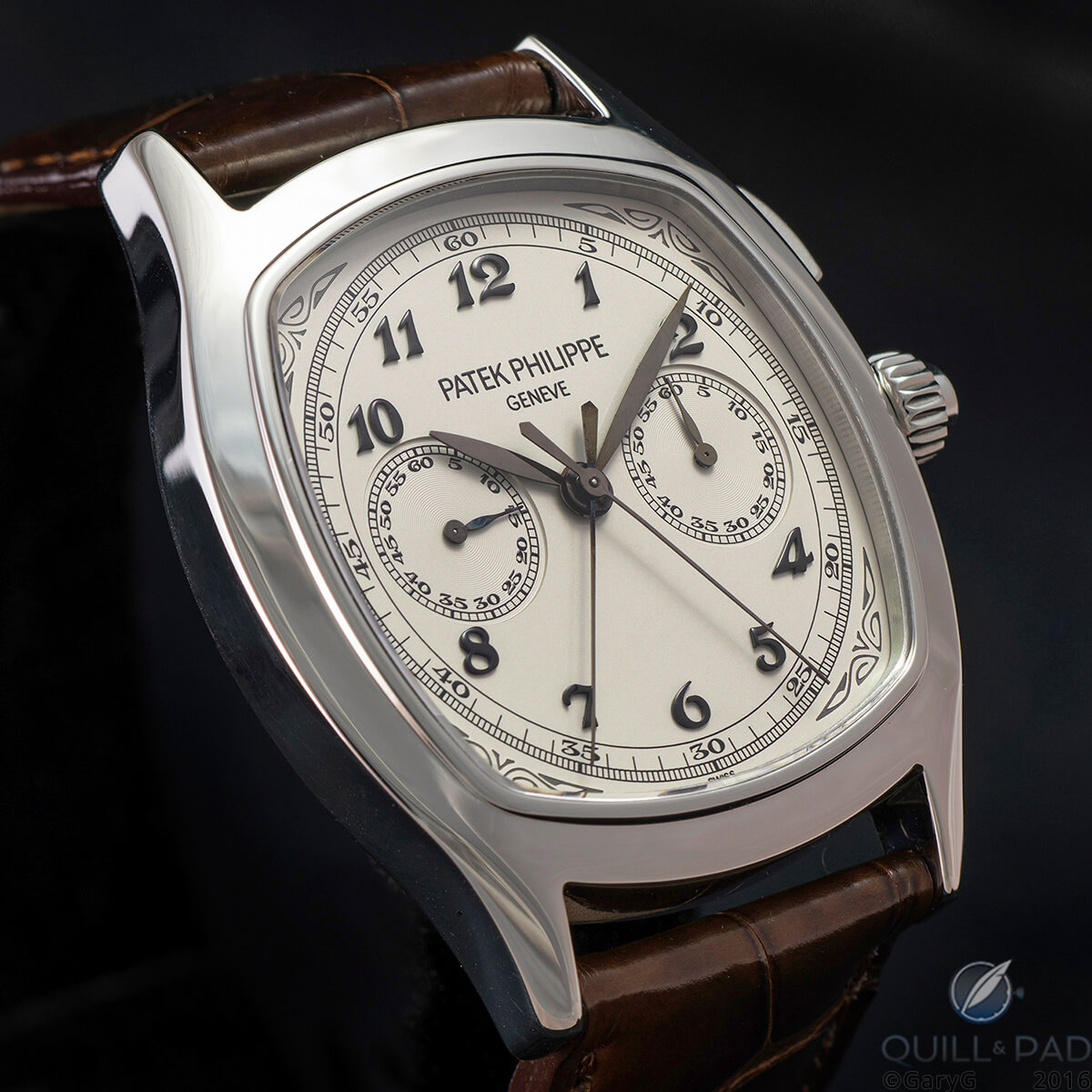
Rhapsody in stainless steel: Patek Philippe Reference 5950A-001
As you can already see from the photos above, with its shape and design elements including filled engravings in the corners of its dial, this isn’t exactly a “Plain Jane” Patek Philippe, if indeed there is such a thing.
It is, however, firmly grounded in Patek Philippe tradition as the cushion-shaped case design harkens directly to some classic Patek Philippe watches from the late 1920s.
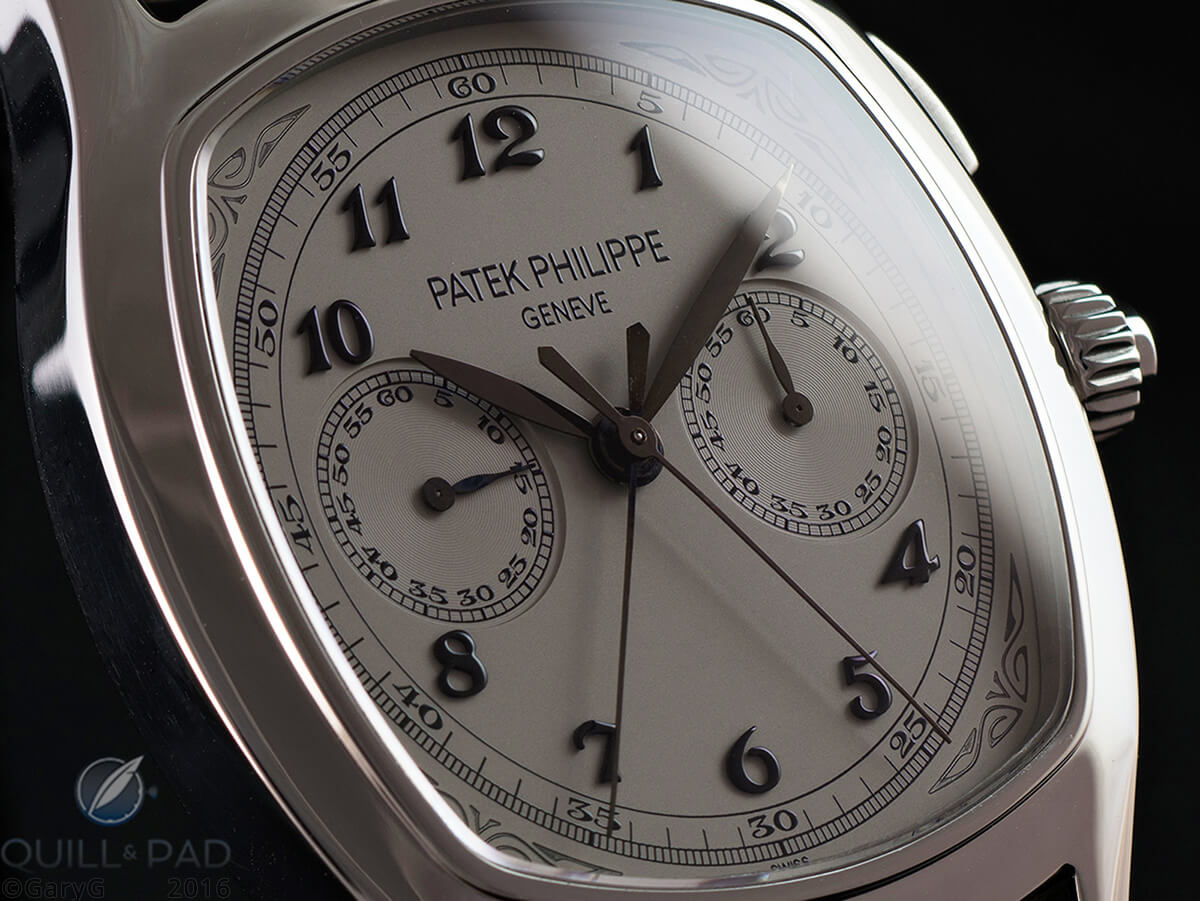
Dial detail on Patek Philippe’s Reference 5950A-001
When it comes to the dial of this watch, in my opinion the closer you get the better it looks. In the highly shadowed image above, you can begin to get a true sense for the wonderful dimensionality of the dial, including the sensuously curved applied hour numerals, grooved subdials, and raised, glossy printing.
There are also the engraved and filled embellishments in the corners of the dial that led me to dub this watch the “Cowboy Bob” when I first saw it as the style struck me more as Wild West than Belle Époque.
In many ways, that scrollwork seems to be the make-or-break aspect of the design among collectors, with some of my friends proclaiming the 5950 as the ultimate Patek Philippe dial design and others (yours truly included) finding it a bit fussy for our tastes.
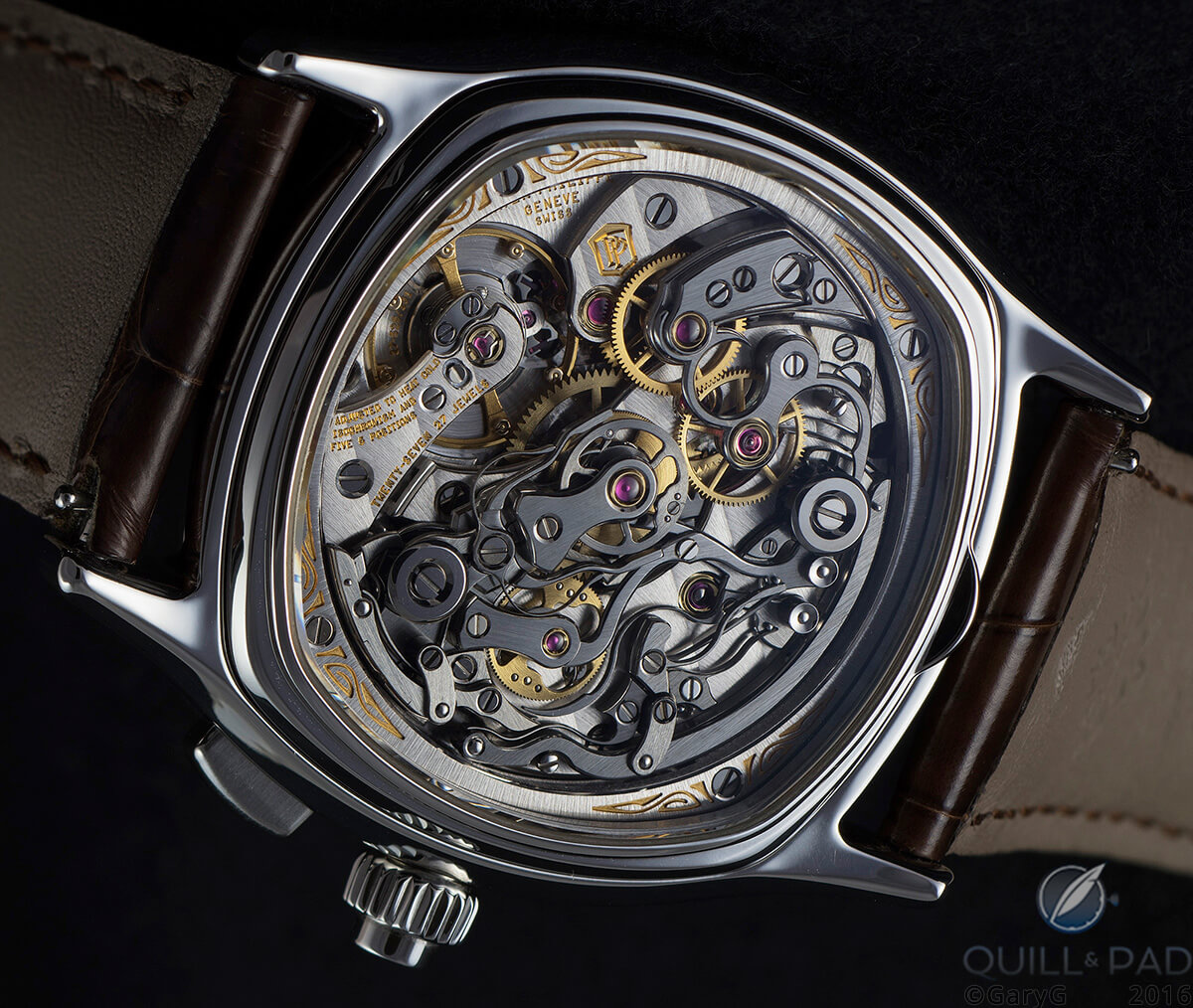
Behind the scenes: Caliber CHR 27-525 PS of Patek Philippe Reference 5950A-001
I have absolutely no reservations, however, about the appearance of the movement. With the exception of a few brightly polished features to catch our eyes such as the caps on the column wheels, Patek Philippe chose to use a fairly subdued set of brushed finishes and a dark tonal palette for this movement.
For me the entire thing just oozes class.
The riot of springs, levers, bridges, and wheels needed to make this watch do its chronographic magic would, for me, be almost too much to take had Patek Philippe used a flashier approach to finishing; happily, the way that the brand’s chosen finishes catch the light both invites us to linger over some of the elegant curves and hand-finished interior angles and provides a sense of real depth to what is, after all, an ultra-thin chronograph movement.
Photographing Reference 5950
At first glance, you might think that this would be a simple watch for the photographer to capture, but in reality it presents some significant challenges.
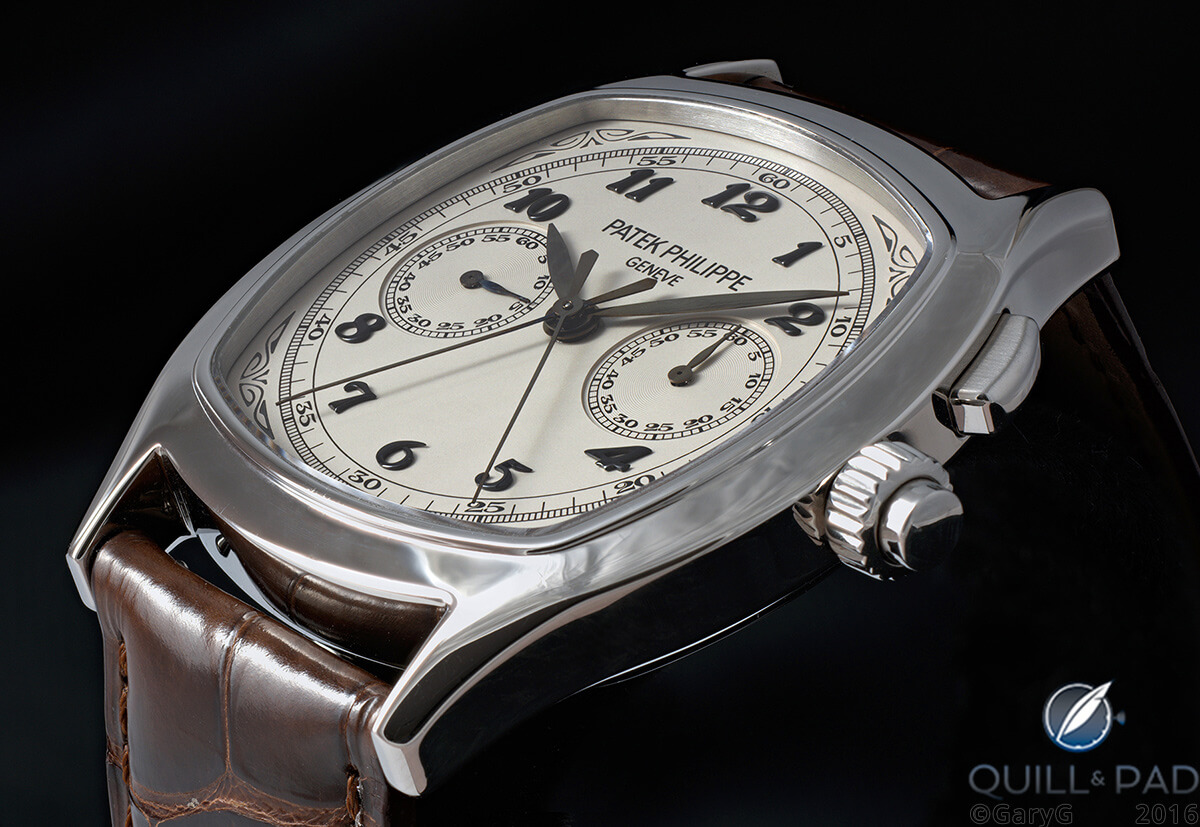
In repose: shallow angle stacked image of Patek Philippe Reference 5950A-001
By playing around a bit with watch placement and camera angle, it’s fairly easy to give a good sense of the shape of the case and the subtle curves of its integral design; for instance, as you’re checking out the photo above it’s easy to notice how the lugs flow organically from the bezel and case band.
The problem element for the photographer with this watch is the dial. While in most photos and renderings the dial appears to be either plain white or silver, and Patek Philippe refers to it as “silvery grained,” in real life it’s more of an ivory color that is very difficult to capture accurately.

Not quite like the book: my photo of Patek Philippe Reference 5950A (right) compared with the catalogue rendering
The “grained” part is definitely true, though, and that’s where the fun really begins as under light tent conditions the grained surface acts as if it is made up of thousands and thousands of tiny prisms, each intended to refract light to throw off unwanted magenta and cyan highlights.
In addition, the irregular dial surface softens the shadows thrown by elements such as the raised numerals enough that stacking software, designed to find the sharpest pixels in each of a number of “stacked” images in order to extract a clear single photo, gets confused in many cases. The resulting image shows diffuse shaded blobs rather than crisp shadows. And, the shallower the angle of view, the more pronounced these effects become.
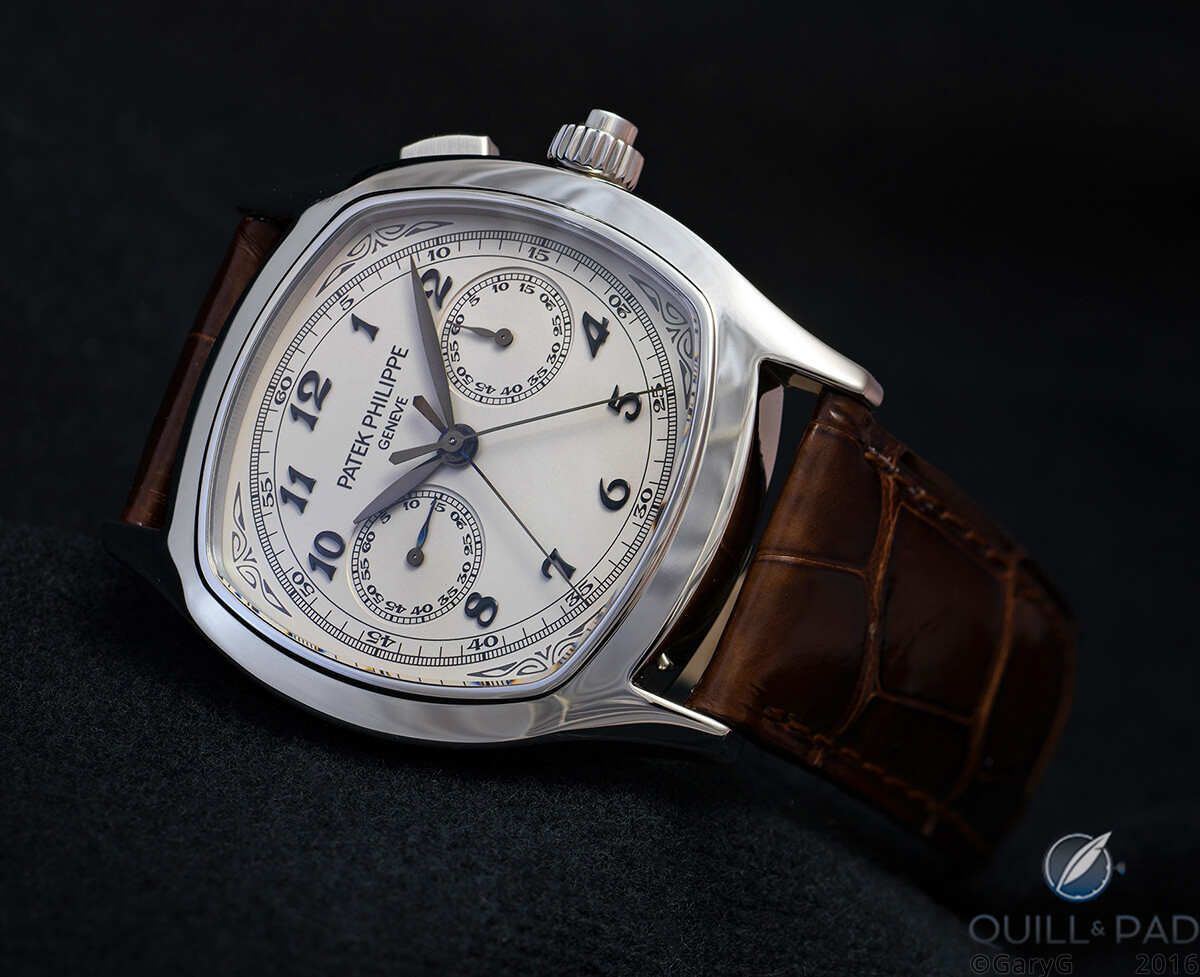
Harder than it looks: photographing the Patek Philippe Reference 5950A
Salvation for the humble amateur photographer is in store on the movement side; it seems almost impossible to light it poorly, the different surface finishes catch and throw light in interesting ways, and there’s plenty going on to keep the eye busy.
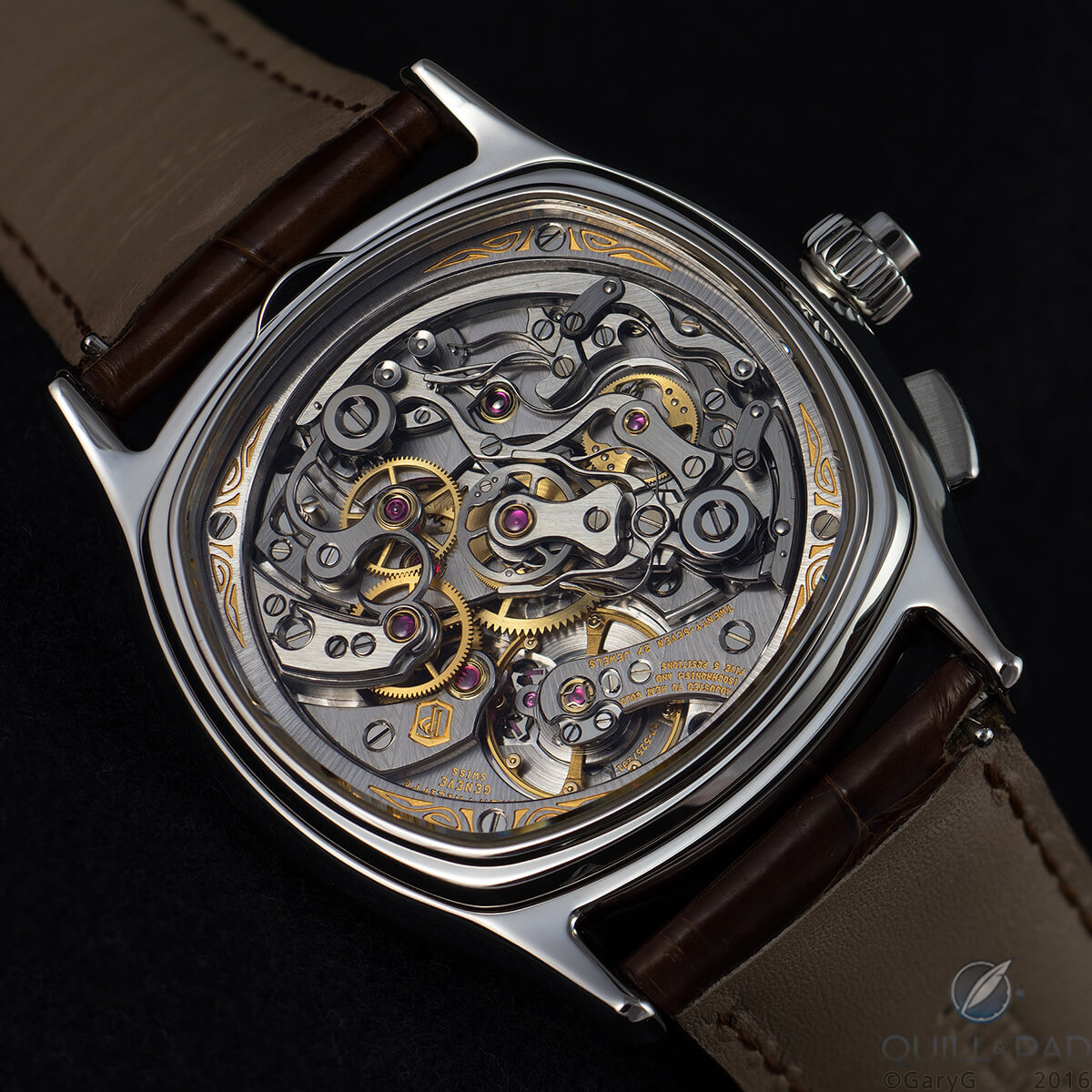
A photographer’s dream: Patek Philippe Caliber CHR 27-525 PS
One of the most interesting elements of this watch isn’t even on the body of the piece itself, but rather on the tang buckle (interestingly enough, made from white gold), where we are greeted with a reprise of the decorative engravings that appear on the corners of the dial and the movement spacer ring.
The same motif is also present on the corners of the solid steel second case back that accompanies the watch.
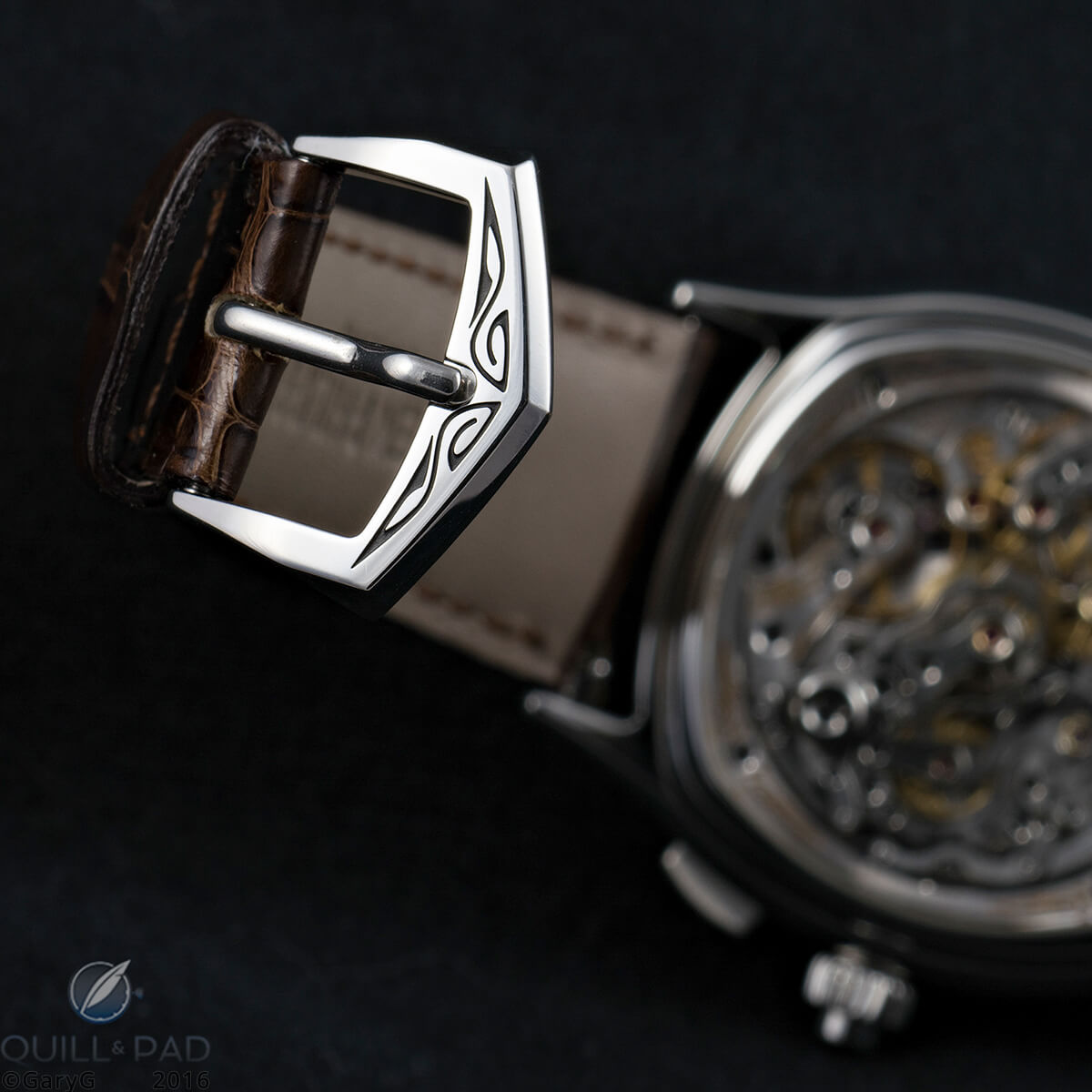
Cowboy Bob rides again: ornamental scrollwork on Patek Philippe Reference 5950A-001’s buckle
Ultimately, for me the acid test for any watch design is coherence: do all of the choices made by the designer make sense together and is the result a harmonious expression rather than a jarring exhibition?
Even though the 5950 is not at the top of my personal wish list, for me it passes the coherence test with flying colors, and I can completely understand why for many leading Patek Philippe collectors this piece is their top “object of desire.”
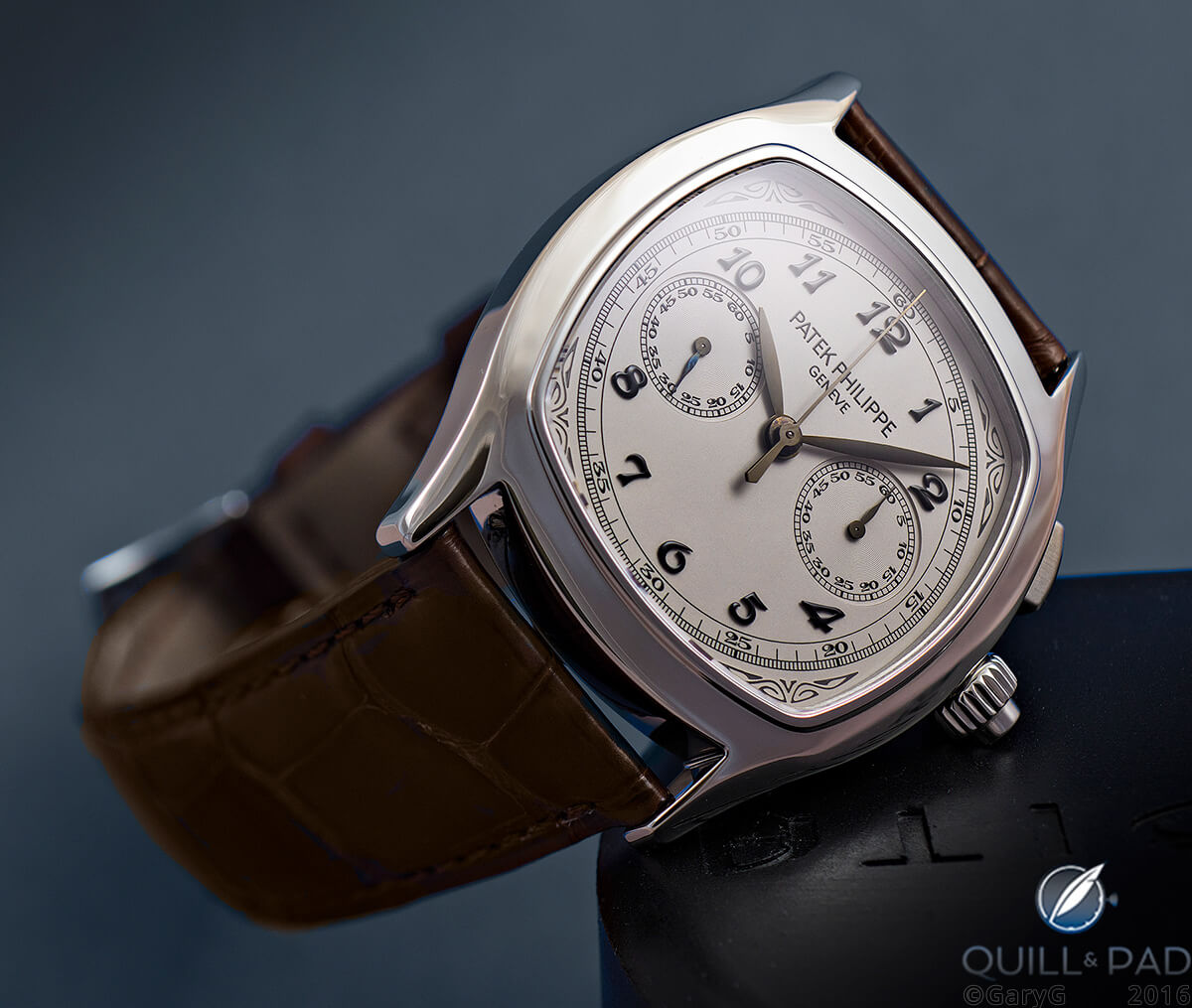
Parting shot: Patek Philippe Reference 5950A-001
For more information (although on the red gold model), please visit www.patek.com/en/mens-watches/grand-complications/5950R-001.
Quick Facts
Case: stainless steel, 37 x 44.6 mm
Dial: silvery grained dial, applied Breguet numerals, engraved scrollwork
Movement: manually wound Caliber CHR 27-525 PS; 21,600 vph (3Hz) frequency, power reserve 48 hours with chronograph disengaged
Functions: hours, minutes, subsidiary running seconds; 60-minute monopusher chronograph with rattrapante (split-seconds function)
Price: final original retail price 441,600 Swiss francs; most recent (2014-15) auction prices $293,000 – $347,000
Production years 5950A-001 in stainless steel: 2010-2015
Trackbacks & Pingbacks
-
[…] black enamel dial on the Reference 5370 or the achingly beautiful rounded Breguet numerals on the Reference 5950, their work is in my opinion right at the top of the […]
-
[…] none-too-shabby Patek Philippe 5950 split-second chronograph is powered by a 3 Hz movement, as is the Vacheron Constantin Harmony Ultra-Thin Grande Complication […]
Leave a Reply
Want to join the discussion?Feel free to contribute!



Great read, and great photos as always. Do you think the price is justifiable ? Not sure how this is, but I know you’re the perfect person to ask as you have acquired an ALS double split and the 5370P, both close to my heart and am a proud owner. Although very different, if you had a budget to get a good deal PP, would you aim at the 5950A or go for a perpetual chrono like a 3970, 5004, 5970. They are all very different, I’m looking at this from a pure value, rarity, and functionality perspective.
That’s a tough set of questions! Value, rarity, and functionality are pretty distinct criteria in my view, for instance.
I love both the 5004 and 5970 (the latter in WG has been on my wish list for years now) and the 5950 has less personal appeal to me aesthetically than those two — but that’s just a matter of personal preference. For absolute rarity and “specialness” of the movement, it is very hard to beat the 5950 — just the quality of finishing and the use of interior angles on the 5950 movement put it a level above the others, in my view.
Hope that is helpful — happy hunting!
Best, Gary
Extremely helpful, thank you, and the term cowboy bob really suits this reference : ))))
I’ve never seen it in real, if you post higher resolution imagines on IG or anywhere else please do let me know.